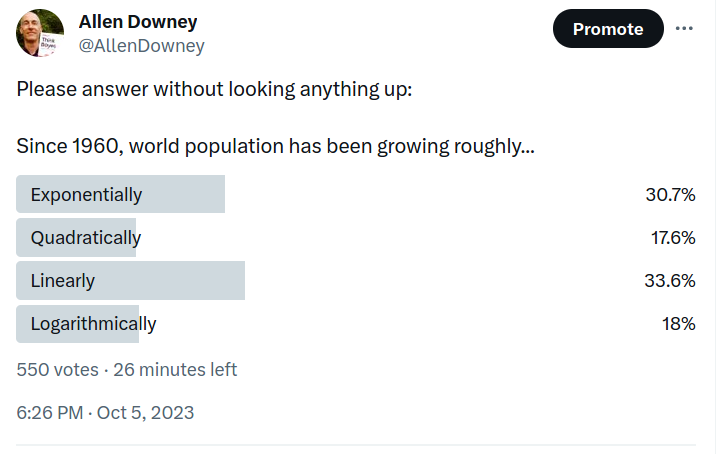How Does World Population Grow?
Recently I posed this question on Twitter: “Since 1960, has world population grown exponentially, quadratically, linearly, or logarithmically?”
Here are the responses:

By a narrow margin, the most popular answer is correct — since 1960 world population growth has been roughly linear. I know this because it’s the topic of Chapter 5 of Modeling and Simulation in Python, now available from No Starch Press and Amazon.com.
This figure — from one of the exercises — shows estimates of world population from the U.S. Census Bureau and the United Nations Department of Economic and Social Affairs, compared to a linear model.

That’s pretty close to linear.
Looking again at the poll, the distribution of responses suggests that this pattern is not well known. And it is a surprising pattern, because there is no obvious mechanism to explain why growth should be linear.
If the global average fertility rate is constant, population grows exponentially. But over the last 60 years fertility rates have declined at precisely the rate that cancels exponential growth.
I don’t think that can be anything other than a coincidence, and it looks like it won’t last. World population is now growing less-than-linearly, and demographers predict that it will peak around 2100, and then decline — that is, population growth after 2100 will be negative.
If you did not know that fertility rates are declining, you might wonder why — and why it really got going in the 1960s. Of course the answer is complicated, but there is one potential explanation with the right timing and the necessary global scale: the Green Revolution, which greatly increased agricultural yields in one region after another.
It might seem like more food would yield more people, but that’s not how it turned out. More food frees people from subsistence farming and facilitates urbanization, which creates wealth and improves public health, especially child survival. And when children are more likely to survive, people generally choose to have fewer children.
Urbanization and wealth also improve education and economic opportunity, especially for women. And that, along with expanded human rights, tends to lower fertility rates even more. This set of interconnected causes and effects is called the demographic transition.
These changes in fertility, and their effect on population growth, will be the most important global trends of the 21st century. If you want to know more about them, you might like:
- Chapters 5-9 of Modeling and Simulation in Python, now available from No Starch Press and Amazon.com.
- Chapter 3 of Probably Overthinking It, which is available for preorder now.
- This Kurtzgesagt video, which was coincidentally published while I was running my poll.